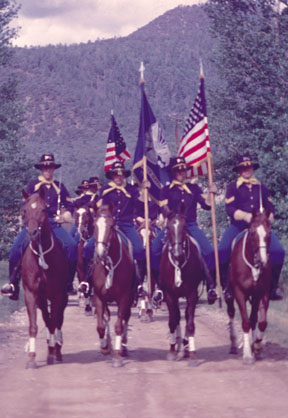
Ft. Burgwin Renaissance
To mark the 150th anniversary of Fort Burgwin, SMU-in-Taos plans to celebrate the birth and rebirth of the frontier outpost. In commemoration, the parade ground will again echo with the sound of soldiers and the once familiar song of the blacksmith’s hammer during the annual open house on June 22 – 23.
“Specialists in re-creating frontier life will join us for a weekend,” said Ron Wetherington, SMU anthropology professor and head of the archaeological field school at the fort. “Students and visitors are invited to the traditional open house but this one will be much more impressive.”
Dragoon soldiers, infantrymen and artillerymen will again man the fort, their tents pitched alongside the parade ground. A frontier surgeon will demonstrate medicines and equipment. A blacksmith will share the craft of ironworking.
“We’ll hold tours of the fort,” Wetherington said, “and provide a living history through demonstrations and discussions.”
Fort Burgwin has become an attractive adjunct to the SMU campus and curriculum. It began as a humble outpost on the American frontier. Cantonment Burgwin, as it was known, was built as a reaction to the conflict between American settlers, the Apaches and native Puebloans.
After abandonment, the fort deteriorated and merged with the landscape. In the early 1960s the fort was rediscovered by Fred Wendorf, who also created the anthropology department at SMU. He brought the partially-resurrected fort to the attention of the board of trustees and was instrumental in the university’s acquisition of the complex as a field school and eventually a campus.
In addition to the traditional archaeological field school taught by Wetherington, professor Mike Adler of the anthropology department will offer “Introduction to Archaeology”, as well as a lab science course, at the fort this summer.
“Archaeological approaches to the past are best learned through actual field experiences, and that is how the courses are designed,” Adler said. “Emphasis is on hands-on experience, field trips to local sites and Native American communities, and laboratory work with actual artifacts. The SMU-in-Taos campus was built around archaeology, and it’s a wonderful place to learn about how we interpret past human cultures.”
The Taos campus is located in the rugged Carson National Forest in northeast New Mexico, whose namesake Kit Carson à the frontier scout and interpreter à often accompanied campaigns from the fort. The U.S. government declared New Mexico a U.S. territory during the war with Mexico and built the fort to protect Taos area settlers from roaming Apaches and Commanches. It was closed in 1860 when troops were consolidated at Fort Union, some 50 miles to the southeast.
Wendorf rediscovered the lost and forgotten fort in 1956 and plans were initiated to excavate and restore the site as a research center.
SMU President Willis Tate and Texas Gov. William Clements visited Taos in the early Ã60s. Clements asked Wendorf what he intended to do.
“I told him,” Wendorf said, “I want to build 10 dormitories, a dining hall, a water system with a tower, wells and sewer lines. We need to build a small town.”Since then, students and faculty have excavated six of the dozen or more original structures. Many are now restored as house offices, laboratories, classrooms, a library and living quarters.
Fort Burgwin is “a very attractive adjunct to the departments at SMU,” Clements reflected, “particularly history and archaeology and subsequently the geology department.”
In addition, the art, theater and English departments became interested.”It provided a real outlet for facets of SMU’s faculty and curriculum that was totally different from anything on the campus,” Clements said.
The Fort Burgwin campus has since brought the area to the status of an intellectual and artistic center. Currently, classes in art, drama, biology, archaeology and more are offered during spring and summer sessions.
Seats are still available for both the field school and introductory archaeology courses this summer. This year’s celebration is a rare opportunity for students to experience a more complete view of the past with historical re-enactments in addition to the archaeological excavations.
Wetherington, who directed the excavation of several of the original buildings, is excited about the upcoming celebration and this summer’s dig.
“Each excavation we conduct holds a double promise,” he said. “One is the historic information it gives us that existing documents cannot provide, and the other is the restoration that provides additional facilities for the growing campus.”










